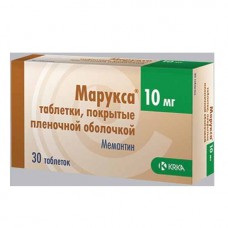Expiration date: 01/2026
Release form, composition and packaging
Tablets, film-coated white color, oval, lenticular, scored on one side, view on fracture - uneven white surface.
1 tablet contains:
memantine hydrochloride 10 mg
Excipients: lactose monohydrate 51.45 mg microcrystalline cellulose 175 mg, silica colloidal anhydrous 2.5 mg, 9.8 mg of talc, magnesium stearate 1.25 mg.
The composition of the film shell: methacrylic acid and ethylacrylate copolymer (1:1), 30% aqueous dispersion, 0.6 mg (based on dry substance, also contains sodium lauryl sulfate and Polysorbate-80 as emulsifier), talc, 0.27 mg, 0.12 triacetin mg, simethicone 0.01 mg.
Pharmacological action
Drugs, neurometabolic, nootropic.
Pharmacodynamics
A derivative of adamantane. Is a non-competitive antagonist of N-methyl-D-aspartate (NMDA) receptors, exerts a modulatory action on glutamatergic system. Regulates ion transport, blocks the calcium channels normalizes the membrane potential, improves the process of transmission of nerve impulse. Improves cognitive processes, increases daily activity.
Pharmacokinetics
Suction
Rapidly and completely absorbed after ingestion. Tmax in plasma — 3-8 h after ingestion. In patients with normal renal function cumulative effect of memantine is not observed.
Distribution
When taken daily in a dose of 20 mg/day Css of memantine in the blood plasma of 70-150 ng/ml When using a daily dose of 5-30 mg was calculated the ratio of the average concentration in the cerebrospinal fluid to the concentration in the blood plasma, is 0.52. Vd is about 10 l/kg. About 45% of memantine is bound to plasma proteins.
Metabolism
About 80% of the interior of memantine is excreted unchanged. The primary metabolites are N-3,5-dimethyl-guantan, isomeric mixture of 4 - and 6-hydroxy memantine and 1-nitroso-3-5-dimethyl-adamantan do not have their own pharmacological activity. In vitro metabolism carried out by cytochrome P450 isoenzymes, has been identified.
Excretion
In the study when administered 14C-memantine on average 84% of the oral dose were withdrawn within 20 days, with more than 99% were withdrawn by the kidneys. Excreted monoeksponencialno. T1/2 terminal phase is from 60 to 100 h. in volunteers with normal renal function total clearance amounts to 170 ml/min/1.73 m2, part of total renal clearance is achieved by tubular secretion. Renal excretion also involves tubular reabsorption, probably mediated by cation transport proteins. The renal elimination rate of memantine under conditions of alkaline urine may decrease to 7-9 times. Alkalinisation of the urine can be caused by a change of diet, for example the transition from a diet including animal products to a vegetarian diet, or due to intensive use of alkaline gastric buffers.
Linearity
Studies conducted in volunteers showed linearity of pharmacokinetics in the dose range of 10-40 mg.
Pharmacokinetic/pharmacodynamic dependence
The application of memantine at a dose of 20 mg/day, the level of concentration in the cerebrospinal fluid corresponds to the magnitude of the inhibition constants (ki) that memantine is 0.5 µmol in the region of the frontal cortex of the brain.
Testimony
Dementia moderate and severe degrees of severity in Alzheimer's disease.
Contraindications
- hypersensitivity to memantine and other components of the drug,
- severe hepatic impairment (class C child-Pugh),
- lactase deficiency, lactose intolerance, syndrome of glucose-galactose malabsorption, because the preparation of Maruxa® includes lactose,
- pregnancy, breastfeeding,
- the age of 18 years (efficacy and safety not established).
Caution: epilepsy, hyperthyroidism, predisposition to seizures concurrent use of other antagonists of NMDA receptors (amantadine, ketamine, dextromethorphan), factors that increase urinary pH (abrupt change in diet, for example, the transition to vegetarianism, excessive intake of alkaline gastric buffers), renal tubular acidosis, severe urinary tract infection, ?????????Proteus spp. myocardial infarction (in anamnesis), heart failure III–IV functional class NYHA classification, uncontrolled hypertension, renal failure, liver failure.
Application of pregnancy and breastfeeding
In connection with the possible delay of prenatal development drug Maruxa® is not used during pregnancy.
Information on the allocation of memantine breast milk does not. However, given the lipophilicity of memantine, selection is possible. Therefore, at the time of treatment with a medication Maruxa® breastfeeding should be discontinued.
Side effects
Classification of frequency of side effects, the who: very often — ?1/10, often from ?1/100 to <,1 10="" 1="" 1000="" 100="" 10000="" p="">,
In clinical studies, the overall incidence of adverse reactions did not differ when receiving memantine and placebo. Usually they were mild to moderate severity. The most common adverse reactions in the memantine group compared to placebo were: dizziness (6,3 vs. 5.6%, respectively), headache (of 5.2 vs 3.9%), constipation (to 4.6 against 2.6%), somnolence (3.4 vs 2.2%) and hypertension (4,1 vs 2.8%).
Side effects are presented according to the classification of MedDRA.
Infectious and parasitic diseases: rarely a fungal infection.
The immune system: common — hypersensitivity to the drug.
Mental disorders: common — drowsiness, rarely — confusion, hallucinations*, frequency unknown — psychotic reaction.
From the nervous system: often — dizziness, impaired balance, rarely — violation of gait; very rarely seizures.
Heart: rarely — heart failure.
From vessels: often — increased blood pressure, rarely, venous thrombosis/thromboembolism.
The respiratory system of the chest and mediastinum: often — shortness of breath.
By the blood: often — constipation, rarely — nausea, vomiting, frequency unknown — pancreatitis.
The liver and biliary tract: often — increased activity of liver enzymes, frequency unknown — hepatitis.
General disorders injection site: often — headache, rarely — fatigue.
* Hallucinations have been observed in patients with Alzheimer's disease at the stage of severe dementia.
During post-marketing use were reported the following adverse reactions: dizziness, drowsiness, irritability, fatigue, anxiety, povyshenie, nausea, hallucinations, headache, impaired consciousness, hypertonia, gait disturbance, depression, convulsions, psychotic reactions, suicidal thoughts, constipation, nausea, pancreatitis, candidiasis, increased blood pressure, vomiting, cystitis, increased libido, venous thrombosis, thromboembolism, and allergic reactions.
Interaction
Potentiated effects of levodopa, dopamine receptor agonists and anticholinergic drugs.
The effectiveness of barbiturates, antipsychotic (neuroleptics) drugs decreases on the background of the simultaneous use of memantine.
Concomitant use of memantine with dantrolene and baclofen and antispasmodics can be accompanied by a change in their effect, which requires dose adjustment of these drugs.
Avoid concurrent use of memantine and amantadine in connection with the risk of developing psychosis. Memantine and amantadine belong to the group of antagonists of NMDA receptors. The risk of psychosis is also increased with concomitant use of memantine with phenytoin, ketamine, and dextromethorphan.
With simultaneous use with cimetidine, ranitidine, procainamide, quinidine, quinine and nicotine increases the risk of increasing the concentration of memantine in the blood plasma.
While concurrent use with hydrochlorothiazide may reduce the concentration of hydrochlorothiazide in plasma by increasing its elimination from the body.
May increase MHO patients, at the same time receiving indirect oral anticoagulants (warfarin). It is recommended to regularly monitor PV or MHO.
Concurrent use with antidepressants, SSRIs and MAO inhibitors requires careful monitoring of the patients.
Not marked drug interactions with a single concomitant use of memantine with glibenclamide/Metformin or donepezil in healthy volunteers.
In concurrent usage with memantine were no changes in the pharmacokinetics of galantamine in healthy volunteers.
In vitro memantine does not inhibit the isoenzyme CYP1A2, 2A6, 2C9, 2D6, 2E1, 3A, monooxygenase, containing flavin, epoxyphenols or sulfation.
Method of application and doses
Inside, 1 time a day and always at the same time, regardless of the meal.
Therapy should be conducted under the supervision of a physician experienced in the diagnosis and treatment of dementia in Alzheimer's disease. Therapy should be initiated only in case if a person regularly caring for a patient, will monitor the intake of medication. The diagnosis must be made in accordance with current recommendations. Should be conducted to assess the tolerability and the dose of Maruxa®, preferably within 3 months after the start of therapy. Followed regularly to assess the clinical efficacy of the drug and tolerability of the therapy in accordance with clinical guidelines. Supportive therapy can continue indefinitely in the presence of therapeutic effect and good tolerability of Maruxa®. Discontinue use of the drug Maruxa®, if the therapeutic effect is not observed or the patient does not tolerate therapy.
To reduce the risk of side effects that gradually increasing doses: 5 mg/week for the first 3 weeks of therapy. The recommended maintenance dose is 20 mg/day.
We recommend the following dosing regimen:
1st week (1-7 day): daily dose 5 mg (½tab. Maruxa® 10 mg every other day for 7 days)
2nd week (8-14 day): daily dose 10 mg (1 table. Maruxa® 10 mg every other day for 7 days)
3rd week (15-21 day) daily dose — 15 mg (1½ table. Maruxa® 10 mg every other day for 7 days)
since 4 weeks: daily dose 20 mg (2 table. Maruxa® 10 mg every other day).
Special groups of patients
Elderly patients (over 65 years). Dose adjustment is not required.
The impairment of renal function. Patients with Cl creatinine 50-80 ml/min dose adjustment is not required. Patients with moderate renal insufficiency (Cl creatinine 30-49 ml/min) the recommended dose of 10 mg/day. With good tolerability for 7 days dose can be increased to 20 mg/day according to the standard scheme. In patients with severe renal insufficiency (Cl creatinine 5-29 ml/min) dose should be 10 mg/day.
The liver dysfunction. In patients with slight and moderate impaired liver (class A and b on a scale child-Pugh) dose adjustment is not required.
Overdose
Symptoms: increased severity of side effects such as fatigue, weakness, diarrhea, confusion, drowsiness, dizziness, agitation, hallucinations, gait disturbance, nausea. In the most serious case of an overdose of 2,000 mg (memantine) patient survived, there have been adverse reactions from the nervous system (coma for 10 days, then diplopia and agitation). The patient received symptomatic treatment and plasmapheresis. The patient recovered without further complications. In another case of severe overdose (400 mg), the patient had also survived and recovered. Described side reactions with storonychne: restlessness, psychosis, visual hallucinations, convulsive, drowsiness, stupor and loss of consciousness.
Treatment: symptomatic. The specific antidote of the drug does not exist. It is necessary to conduct a standard therapeutic measures aimed at elimination of the active substance from the stomach, e.g. gastric lavage, administration of activated charcoal, acidification of the urine, it is possible to conduct a forced diuresis.
Special instructions
It is recommended to use with caution in patients with epilepsy, convulsions in history or predisposition to epilepsy.
Avoid concurrent use of memantine and other antagonists of NMDA receptors such as amantadine, ketamine or dextromethorphan. These compounds act on the same receptor system as memantine, and therefore adverse reactions (mainly CNS-related) may occur more frequently and be more pronounced.
The patient factors influencing the increase of pH of urine (sudden changes in diet, such as the transition from a diet including animal products to a vegetarian diet, or heavy consumption of gastric alkaline buffers), and renal tubular acidosis or severe infections of the urinary tract caused by Proteus spp. require careful monitoring of the patient's condition.
Most clinical trial of patients with myocardial infarction in anamnesis, decompencirovannah (III–IV functional class NYHA classification), or uncontrolled hypertension were excluded. Therefore, data on the use of memantine in these patients are limited, the drug must be administered under close medical supervision.
Effects on ability to drive vehicles and operate machinery. In patients with Alzheimer's disease at the stage of moderate and severe dementia usually impaired ability to drive vehicles and management of complex mechanisms. In addition, memantine can cause a change reaction rate, therefore, patients should refrain from driving or operating complex mechanisms.
Release form
Tablets, film-coated, 10 mg. In a contour acheikova package from the combined material of PVC/PVDC and aluminum foil, 10 PCs 3 or 6 contour cell packs in a cardboard pack.


